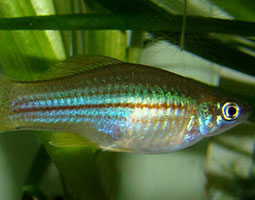Xiphophorus hellerii
Description

Green swordtails (Xiphophorus hellerii) are generally less than 8cm in length, however they can grow to a maximum total length of 16 cm with the female growing to a larger size than the male. They are called a 'swordtail' because the male has a longer lobe on the lower half of their caudal tailfin which looks like the blade of a sword. The natural colouration of this species is bronze to olive green with a red to brown stripe down their lateral line and fine spots on their dorsal fin. The lower lobe of the tail fin of males tends to be yellow with black on the edges. Aquarium enthusiasts have however actively bred this species in captivity resulting in a wide range of more exotic colours and patterns.
This invasive species prefers to breed at a water temperatures of around 26oC, and can start breeding 3 months after hatching. Swordtails are live-bearers and can produce 50–100 fry every time, and can give birth again 4-6 weeks later, although this can vary a bit depending on conditions such as stress and food. Females can also give birth without the presence of a male as they have the capacity to store sperm inside a pouch and fertilize their eggs on their own over and over again. It is natural for this fish to eat their own fry and so the female will try to give birth away from other Swordtails, especially the males.
The Green swordtail is native to Central America. It has however, become an invasive pest in a range of countries due to release by amateur aquarium hobbyists. As a result, it has caused extensive ecological damage due to its high reproductive rate, broad range of tolerance limits, aggressive behaviour and ability to out-compete native fish for habitat and food. Invasive populations have established themselves in a number of countries with significant populations established along the Australian east coast where it prefers fast-flowing rivers and streams with significant vegetation. It may also inhabit more urban waters such as warm drains, culverts, ditches, ponds and canals.
Adaptations
- Highly territorial and will fight with native fish for space
- Actively eats eggs of native fish to reduce population in their territory
- Broad tolerance limits and food sources
- High reproductive rate to establish populations rapidly in new areas
Feeding relationships
- What I eat: Aquatic plants, detritus, small crustaceans, insects and worms
- What eats me: Carnivorous fish, birds (e.g. Egret), crayfish, turtles, large predatory insects (e.g. water scorpion)
Interesting facts
The males' "sword" has been found to have a significant impact on their chances at mating. The presence of a well-endowed male encourages the maturity of females, while it inhibits the maturity of juvenile males inhabiting the territory of a well-endowed male.